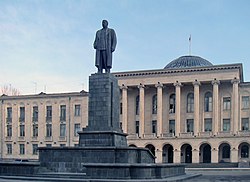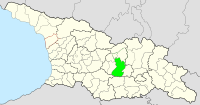Gori, Georgia
Gori
გორი | |
|---|---|
City | |
|
From top: Town Hall, Gori Fortress, Gori Cathedral, FC Dila Stadium, Panoramic view to Gori | |
|
UTC+4 (Georgian Time) | |
| Postal code | 1400 |
| Climate | Cfb |
| Website | www |
 | |
Gori (
A settlement known here from the
Gori is also known as the birthplace of
Geography and climate
Gori is located 86 kilometres west of Georgia's capital
Highest recorded temperature: 38.0 °C (100.4 °F) on 13 August 2006[2]
Lowest recorded temperature: −22.2 °C (−8.0 °F) on 16 December 2004[2]
| Climate data for Gori (1991–2020 normals, extremes 1981-2020) | |||||||||||||
|---|---|---|---|---|---|---|---|---|---|---|---|---|---|
| Month | Jan | Feb | Mar | Apr | May | Jun | Jul | Aug | Sep | Oct | Nov | Dec | Year |
| Record high °C (°F) | 15.6 (60.1) |
20.5 (68.9) |
26.0 (78.8) |
30.5 (86.9) |
32.0 (89.6) |
36.8 (98.2) |
37.4 (99.3) |
38.0 (100.4) |
36.6 (97.9) |
30.9 (87.6) |
25.0 (77.0) |
20.0 (68.0) |
38.0 (100.4) |
| Mean daily maximum °C (°F) | 5.4 (41.7) |
7.1 (44.8) |
12.2 (54.0) |
17.5 (63.5) |
22.2 (72.0) |
26.3 (79.3) |
29.1 (84.4) |
29.7 (85.5) |
25.0 (77.0) |
19.1 (66.4) |
11.8 (53.2) |
6.5 (43.7) |
17.7 (63.9) |
| Mean daily minimum °C (°F) | −3.3 (26.1) |
−2.7 (27.1) |
1.0 (33.8) |
5.1 (41.2) |
9.9 (49.8) |
14.0 (57.2) |
17.2 (63.0) |
17.0 (62.6) |
12.8 (55.0) |
7.4 (45.3) |
1.4 (34.5) |
−2.2 (28.0) |
6.5 (43.7) |
| Record low °C (°F) | −19.6 (−3.3) |
−19.9 (−3.8) |
−15.1 (4.8) |
−10.5 (13.1) |
−1.0 (30.2) |
2.8 (37.0) |
7.7 (45.9) |
6.1 (43.0) |
−0.2 (31.6) |
−4.8 (23.4) |
−11.5 (11.3) |
−22.2 (−8.0) |
−22.2 (−8.0) |
| Average precipitation mm (inches) | 29.0 (1.14) |
28.2 (1.11) |
35.7 (1.41) |
53.1 (2.09) |
65.8 (2.59) |
58.7 (2.31) |
41.3 (1.63) |
36.6 (1.44) |
35.2 (1.39) |
41.9 (1.65) |
47.4 (1.87) |
33.7 (1.33) |
506.6 (19.94) |
| Average precipitation days (≥ 1.0 mm) | 6.4 | 6 | 6.8 | 8.3 | 10.1 | 8.5 | 5.6 | 5.1 | 5.3 | 6.8 | 6.8 | 6.6 | 82.3 |
| Source: | |||||||||||||
History

The territory of Gori has been populated since the early

With the downfall of the medieval
Gori is close to the
2008 conflict

In the 2008
By August 11, Georgian military personnel, government, and most residents had fled the city, which was then
Demographics


| Year | 1865 | 1897 | 1914 | 1916 | 1977 | 1989 | 2002 | 2014 | 2022 | 2023 |
|---|---|---|---|---|---|---|---|---|---|---|
| Population | 5,100[citation needed] | 10,269[16] | 25,355[17] | 18,454[18] | 54,100[19] | 68,924[20] | 49,522[20] | 48,143[21] | 44,524[22] | 44,387[23] |
Graphs are unavailable due to technical issues. There is more info on Phabricator and on MediaWiki.org. |
Landmarks



Gori and its environs house several notable cultural and historical landmarks. Although for many foreigners Gori is principally known as the birthplace of
Stalin's association with the city is emphasized by the Joseph Stalin Museum in downtown Gori and, until recently, the Stalin monument in front of the Gori City Hall, one of the few such monuments to survive Nikita Khrushchev's de-Stalinization program. The monument was a source of controversy in a newly independent Georgia in the 1990s, but for several years the post-communist government acceded to the Gori citizens' request and left the statue untouched.[24][25] It was ultimately removed on June 25, 2010.[26] However, on 20 December 2012, the municipal assembly of Gori voted to reinstate the monument.[27][28]
Administrative divisions
The city is divided into 11 administrative districts, they are:[29]
| No. | District | No. | District | No. | District | No. | District | |||
|---|---|---|---|---|---|---|---|---|---|---|
| 1 | Kvernaki Settlement | 4 | Tsmindatskali 2nd Locality | 7 | Chala-Tskarosubani Settlement | 10 | Central Settlement 1st Locality | |||
| 2 | Verkhvebi Settlement | 5 | IDPs Settlement | 8 | Kombinati Settlement 1st Locality | 11 | Central Settlement 2nd Locality | |||
| 3 | Tsmindatskali 1st Locality | 6 | Sadguri-Elektripikatsia Settlement | 9 | Kombinati Settlement 2nd Locality | |||||
Notable people

- Anastasia Eristavi-Khoshtaria (1868-1951), novelist
- Leader of the Soviet Union and 4th Premier of the Soviet Union
- Simon Arshaki Ter-Petrosian (1882–1922), revolutionary
- Vano Muradeli (1908–1970), composer
- Aleksandre Machavariani(1913–1995), composer
- Aleksandr Nadiradze (1914–1987), inventor
- Edvard Mirzoyan (1921–2012), composer
- Sulkhan Tsintsadze (1925–1991), composer
- Merab Mamardashvili (1930–1990), philosopher
- Giorgi Tenadze (born 1962), wrestler
- Vazha Tarkhnishvili (born 1971), footballer
- Georgi Kandelaki (born 1974), boxer
- Lasha Shavdatuashvili (born 1992), judoka
- Geno Petriashvili (born 1994), wrestler
- Oto Nemsadze (born 1989), singer
- Vladimer Khinchegashvili (born 1991), wrestler, Olympic & World Champion
Important sights

- Gori Cathedral of Saint Mary
- Gori State Historical-Ethnographic Museum
- Joseph Stalin State Museum
- House of Amilakhvris
- Monument to Nikoloz Baratashvili
- Monument to Iakob Gogebashvili
- Gori Pedagogical Institute
- Gori State Drama Theater
- Gori State Historical-Ethnographic Museum
- Gorijvari[30]
- Erekle Baths
- Monument to Giorgi Eristavi
- Monument to Nico Lomouri
- Military city
- Theological School
References
- ^ E.M. Pospelov, Geograficheskie nazvaniya mira (Moscow, 1998), p. 121.
- ^ )
- ^
"World Meteorological Organisation Climate Normals for 1981–2010 - Georgia". National Oceanic and Atmosoheric Administration. p. 5. Archived from the originalon 9 October 2021. Retrieved 9 October 2021.
- ^ Sempad the Constable. Chronicle
- ^ Закарая, П. (1983) Памятники Восточной Грузии. Искусство, Москва, 376 с. [Zakaraya, P. Monuments of Eastern Georgia](In Russian)
- ^ Georgia Today: "Georgian Armed Forces modernize infrastructure" Archived 2007-10-12 at the Wayback Machine, October 4, 2007.
- ^ New military base in Gori Archived 2011-07-21 at the Wayback Machine. Ministry of Defense of Georgia, January 18, 2008.
- ^ "Russian jets attack Georgian town", BBC News, 9 August 2008
- ^ "Georgia conflict: Screams of the injured rise from residential streets", The Telegraph, 10 Aug 2008
- ^ "Georgia: Russian Cluster Bombs Kill Civilians. Stop Using Weapon Banned by 107 Nations" Human Rights Watch, August 15, 2008,
- ^ Александр Брод: западных правозащитников не интересует трагедия Южной Осетии // Полит.ру, 21 августа 2008
- ^ "Georgia: Civilians Killed by Russian Cluster Bomb ‘Duds’. More Attacks Confirmed; Unexploded Ordnance Threatens Many", Human Rights Watch, August 21, 2008
- ^ Russia/Georgia: Militias Attack Civilians in Gori Region; Russia Should Curb Militias and Allow in Humanitarian Aid, Human Rights Watch, August 17, 2008,
- ^ Civil Georgia: "Police Back in Gori", 23 August 2008
- ^ Schwirtz, Michael (24 August 2008). "Georgia Prepares for Refugees; Russians Declare Pullback Finished". The New York Times.
- ^ "Демоскоп Weekly - Приложение. Справочник статистических показателей". www.demoscope.ru. Retrieved 2022-06-29.
- ^ Кавказский календарь на 1915 год [Caucasian calendar for 1915] (in Russian) (70th ed.). Tiflis: Tipografiya kantselyarii Ye.I.V. na Kavkaze, kazenny dom. 1915. p. 245. Archived from the original on 4 November 2021.
- ^ Кавказский календарь на 1917 год [Caucasian calendar for 1917] (in Russian) (72nd ed.). Tiflis: Tipografiya kantselyarii Ye.I.V. na Kavkaze, kazenny dom. 1917. pp. 206–213. Archived from the original on 4 November 2021.
- ^ (in Georgian) Kakabadze, V., Gvasalia, J., Gagoshidze I., Menabde, L., Zakaria, P. (1978), გორი ("Gori"). Georgian Soviet Encyclopedia, vol. 3, p. 226. Tbilisi.
- ^ a b "2002 General Population Census Major Findings" (PDF). National Statistics Office of Georgia. Retrieved 10 May 2016.[permanent dead link]
- ^ "Population Census 2014". www.geostat.ge. National Statistics Office of Georgia. November 2014. Retrieved 28 June 2021.
- ^ "Population by cities and boroughs, as of 1 January 2022". www.geostat.ge. GeoStat. Retrieved 18 May 2022.
- ^ "Population - National Statistics Office of Georgia". www.geostat.ge. Retrieved 2023-06-28.
- ^ Will Lasky. Selling Stalin. Georgian Business Magazine, Issue 4, August 2007.
- ^ Salome Asatiani. Great Terror: In Stalin's Birthplace, Forgiving And Forgetting. Radio Free Europe/Radio Liberty, August 14, 2007.
- ^ "Stalin statue removed in Georgian town of Gori", BBC News, 25 June 2010
- ^ "Georgia: A Stalinist Restoration", The New York Times, 20 December 2012
- ^ "Georgia to Reinstate Stalin Monument", RIA Novosti, 21 December 2012
- ^ "Administrative Entities". gori.gov.ge. Retrieved 9 May 2019.
- ^ "Gorijvari". visitingeorgia.com. 17 July 2015.








